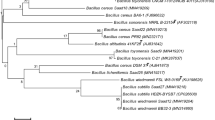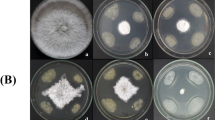Abstract
Sixty-four strains ofRhizobium and seven other rhizosphere bacteria were evaluated by streak-plate, double-layer, and spent-culture methods to determine their antibiotic activity againstMacrophomina phaseolina, causative agent of ‘ashy stem’ blight of beans. Expression of inhibition varied among strains and depended on growth media and screening method. The streak-plate method with yeast extract/mannitol was the best bioassay. Results indicate that root-nodule bacteria have weak biofungicidal potential. A strain ofPseudomonas cepacia (UPR 5C) consistently restricted fungal growth.
Similar content being viewed by others
References
AbawiG.S. & Pastor-CorralesM.A. 1986 Seed transmission and effect of fungicide seed treatments againstMacrophomina phaseolina in beans.Phytopathology 76, 1064.
AbawiG.S. & Pastor-CorralesM.A. 1990Root Rots of Beans in Latin America and Africa: Diagnosis, Research Methodologies and Management Strategies. CIAT Publication No. 35. Cali, Colombia: CIAT.
BeringerJ.E. 1974 R factor transfer inRhizobium leguminosarum.Journal of General Microbiology 84, 188–198.
BuonassissiA.J., CopmanR.J., PepinH.F. & EatonG.W. 1986 Effect ofRhizobium spp onFusarium solani f. sp.phaseoli.Canadian Journal of Plant Pathology 8, 140–146.
ChakrabortyU. & PurkayasthaR.P. 1984 Role of rhizobitoxine in protecting soybean roots fromMacrophomina phaseolina.Canadian Journal of Microbiology 30, 285–289.
Echávez-BadelR. & BeaverJ.S. 1987 Dry bean genotypes andMacrophomina phaseolina (Tassi) Goi in inoculated and non-inoculated field plots.Journal of Agriculture of the University of Puerto Rico 71, 385–390.
HebbarK.P., AtkinsonD., TuckerW. & DartP.J. 1992a Suppression ofFusarium moniliforme by maize root-associatedPseudomonas cepacia.Soil Biology and Biochemistry 24, 1009–1020.
HebbarK.P., DaveyA.G., MerrinJ. & McLoughlinT.J. 1992bPseudomonas cepacia, a potential suppressor of maize soil-borne disease. Seed inoculation and maize root colonization.Soil Biology and Biochemistry 24, 999–1007.
HommaY., SatoZ., HirayamaF., KonnoK., ShirahamaH. & SuzuiT. 1989 Production of antibiotics byPseudomonas cepacia as an agent for biological control of soilborne plant pathogens.Soil Biology and Biochemistry 21, 723–728.
JanisiewiczW.J. & RoitmanJ. 1988 Biological control of blue mold and gray mold on apple and pear withPseudomonas cepacia.Phytopathology 78, 1697–1700.
McLoughlinT.J., QuinnJ.P., BettermannA. & BooklandR. 1992Pseudomonas cepacia suppression of sunflower wilt fungus and role of antifungal compounds in controlling the disease.Applied and Environmental Microbiology 58, 1760–1763.
VincentJ.M. 1970A Manual for the Practical Study of Root-Nodule Bacteria. Oxford: Blackwell Scientific.
YabuuchiE., KosakoY., OyaizuH., YanoY., HottaH., HashimotoT., EzakiT. & ArakawaM. 1992 Proposal ofBurkholderia gen. nov. Transfer of seven species of the genusPseudomonas homology group II to the new genus, with the type speciesBurkholderia cepacia (Palleroni and Holmes 1981) comb. nov.Microbiology and Immunology 36, 1251–1275.
ZapataM., VidaverA.K. & DamR. 1992 Hormone production inXanthomonas campestris pv.phaseoli.Bean Improvement Cooperative 35, 44–45.
Author information
Authors and Affiliations
Additional information
F. Perdomo, M. Alameda and E.C. Schröder are with the BNF Laboratory, Department of Agronomy and Soils, University of Puerto Rico, Mayagüez, PR 00681-5000, USA; R. Echávez-Badel is with the Department of Crop Protection, University of Puerto Rico, Mayagüez, PR 00681-5000, USA.
Rights and permissions
About this article
Cite this article
Perdomo, F., Echávez-Badel, R., Alameda, M. et al. In vitro evaluation of bacteria for the biological control ofMacrophomina phaseolina . World J Microbiol Biotechnol 11, 183–185 (1995). https://doi.org/10.1007/BF00704645
Revised:
Accepted:
Issue Date:
DOI: https://doi.org/10.1007/BF00704645




